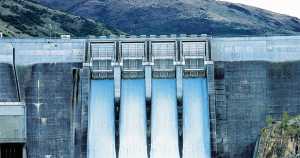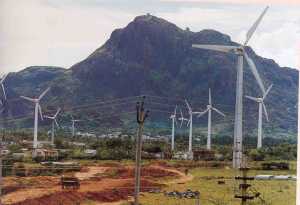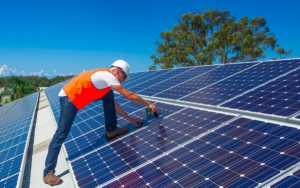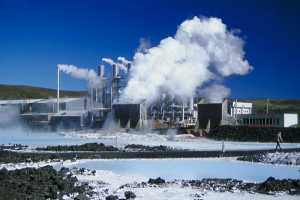Renewable energy sources and technologies have potential to provide solutions to the long-standing energy problems being faced by the developing countries. In this article, the availability, current status, major achievements and future potentials of renewable energy options in India are summarized.
The renewable energy sources like wind energy, solar energy, geothermal energy, ocean energy, biomass energy and fuel cell technology can be used to overcome energy shortage in India. To meet the energy requirement for such a fast growing economy, India will require an assured supply of 3–4 times more energy than the total energy consumed today.
The renewable energy is one of the options to meet this requirement. Today, renewable account for about 33% of India’s primary energy consumption. India is increasingly adopting responsible renewable energy techniques and taking positive steps towards carbon emissions, cleaning the air and ensuring a more sustainable future. In India, from the last two and half decades there has been a vigorous pursuit of activities relating to research, development, demonstration, production and application of a variety of renewable energy technologies for use in different sectors.
Modern biomass encompasses a range of products derived from photosynthesis and is essentially chemical solar energy storage. Renewable energy supplies 18% of the world’s final energy consumption, counting traditional biomass, large hydro-power, and nonrenewable (small hydro, modern biomass, wind, solar, geothermal, and bio-fuels).
Traditional biomass, primarily for cooking and heating, represents about 13% and is growing slowly in some regions as biomass is used more efficiently or replaced by more modern energy forms. Large hydro-power represents 3% and is growing modestly, primarily in developing countries.
Renewable Energy Sources (RES) that use indigenous resources have the potential to provide energy with negligible emissions of air pollutants and green house gases. Renewable energy technologies produce marketable energy by converting natural phenomena/resources into useful energies. The usage of renewable energy resources is a promising prospect for the future as an alternative to conventional energy.
Overview of Renewable energy in India
India’s population of more than 1028 million is growing at an annual rate of 1.58%. As fossil fuel energy becomes scarcer, India will face energy shortages significantly due to increase in energy prices and energy insecurity within the next few decades. Increased use of fossil fuels also causes environmental problems both locally and globally.
There is a very high demand for energy, which is currently satisfied mainly by coal, foreign oil and petroleum, which apart from being a non-renewable, and therefore non-permanent solution to the energy crisis, it is also detrimental to the environment. Thus, it is imperative that India obtains energy security without affecting the booming economy, which would mean that the country must switch from the nonrenewable energy (crude oil and coal) to renewable energy.
The 2022 electrical power targets include achieving 227GW (earlier 175 GW) of energy from renewable sources, nearly 113 GW through solar power, 66 GW from wind power, 10 GW from biomass power, 5GW from small hydro and 31GW from floating solar and offshore wind power. The bidding process for the further additional 115 GW or thereabouts to meet these targets of installed capacity from January 2018 levels will be completed by the end of 2019-2020. The government has announced that no new coal-based capacity addition is required beyond the 50 GW under different stages of construction likely to come online between 2017 and 2022.
The role of new and renewable energy has been assuming increasing significance in recent times with the growing concern for the country’s energy security.
The Indian Government has been at work, making a comprehensive policy for compulsory use of renewable energy resources through biomass, hydro-power, wind, solar and municipal waste in the country, particularly for commercial establishments, as well as Government establishments.
The major contribution to renewable energy investment comes from private sector participation. This is due to the support from the government, which leverages the private investment.
Ministry of Non-conventional Energy Sources is focused on nation-wide resource assessment, setting up of commercial projects, renovation and modernization, development and up-gradation of water mills and industry based research and development.
Biomass:
 In recent years, the interest in using biomass as an energy source has increased and it represents approximately 14% of world final energy consumption. Estimates have indicated that 15–50% of the world’s primary energy use could come from biomass by the year 2050.
In recent years, the interest in using biomass as an energy source has increased and it represents approximately 14% of world final energy consumption. Estimates have indicated that 15–50% of the world’s primary energy use could come from biomass by the year 2050.
Many countries have included the increased use of renewable sources on their political agenda. Biomass is one such resource that could play a substantial role in a more diverse and sustainable energy mix.
Energy production from food wastes or food processing wastes, especially from waste edible oils, seems to be attractive based on bio-resource sustainability, environmental protection and economic consideration.
Biomass power generation in India is an industry that attracts investments of over Rs. 600 crores every year, generating more than 5000 million units of electricity and yearly employment of more than 10 million man-days in the rural areas.
Hydropower:
 Hydro-power is another source of renewable energy that converts the potential energy or kinetic energy of water into mechanical energy in the form of watermills, textile machines, etc., or as electrical energy (i.e., hydroelectricity generation). It refers to the energy produced from water (rainfall flowing into rivers, etc.). Hydro-power is the largest renewable energy resource being used for the generation of electricity. Only about 17% of the vast hydel potential of 150,000 MW has been tapped so far.
Hydro-power is another source of renewable energy that converts the potential energy or kinetic energy of water into mechanical energy in the form of watermills, textile machines, etc., or as electrical energy (i.e., hydroelectricity generation). It refers to the energy produced from water (rainfall flowing into rivers, etc.). Hydro-power is the largest renewable energy resource being used for the generation of electricity. Only about 17% of the vast hydel potential of 150,000 MW has been tapped so far.
In India, hydropower projects with a station capacity of up to 25 megawatt (MW) fall under the category of Small Hydropower (SHP). India has an estimated SHP potential of about 15,000 MW, of which about 11% has been tapped so far. The Ministry of New and Renewable Energy (MNRE) supports SHP project development throughout the country.
Wind Energy:
 Wind energy is being developed in the industrialized world for environmental reasons and it has attractions in the developing world as it can be installed quickly in areas where electricity is urgently needed. In many instances it may be a cost-effective solution if fossil fuel sources are not readily available. In addition there are many applications for wind energy in remote regions,worldwide, either for supplementing diesel power (which tends to be expensive) or for supplying farms, homes and other installations on an individual basis.
Wind energy is being developed in the industrialized world for environmental reasons and it has attractions in the developing world as it can be installed quickly in areas where electricity is urgently needed. In many instances it may be a cost-effective solution if fossil fuel sources are not readily available. In addition there are many applications for wind energy in remote regions,worldwide, either for supplementing diesel power (which tends to be expensive) or for supplying farms, homes and other installations on an individual basis.
Wind power accounts for nearly 10% of India’s total installed power generation capacity and generated 52.67 TWh in the fiscal year 2017-18, which is nearly 3% of total electricity generation.The capacity utilisation factor is nearly 16% in the fiscal year 2017-18 (19.62% in 2016-17 and 14% in 2015-16). 70% of wind generation is during the five months duration from May to September coinciding with Southwest monsoon duration. In India, solar power is complementary to wind power as it is generated mostly during the non monsoon period in daytime.
Solar Energy:
 Solar energy is the most abundant permanent energy resource on earth and it is available for use in its direct (solar radiation) and indirect (wind, biomass, hydro, ocean, etc.) forms. Solar energy, experienced by us as heat and light, can be used through two routes: the thermal route uses the heat for water heating, cooking,drying, water purification, power generation, and other applications the photo voltaic route converts the light in solar energy into electricity, which can then be used for a number of purposes such as lighting, pumping, communications, and power supply in unelectrified areas.
Solar energy is the most abundant permanent energy resource on earth and it is available for use in its direct (solar radiation) and indirect (wind, biomass, hydro, ocean, etc.) forms. Solar energy, experienced by us as heat and light, can be used through two routes: the thermal route uses the heat for water heating, cooking,drying, water purification, power generation, and other applications the photo voltaic route converts the light in solar energy into electricity, which can then be used for a number of purposes such as lighting, pumping, communications, and power supply in unelectrified areas.
The Ministry of New and Renewable Energy (MNRE) has planned a detailed trajectory so as to meet the target of 100 GW by 2022. A capacity of 23.12 GW was installed up to July 2018. Projects of around 10 GW are under implementation and tenders for additional 24.4 GW are issued.India has a good level of solar radiation, receiving the solar energy equivalent of more than 5000 trillion kWh/yr.
The MNRE, working in conjunction with the Indian Renewable Energy Development Agency (IREDA) to promote the utilization of all forms of solar power as well as to increase the share of renewable energy in the Indian market. This promotion is being achieved through R&D, demonstration projects, government subsidy programs, and also private sector projects.
Solar buildings have been promoted by the MNRE in an effort to increase energy efficiency; the state government in Himachal Pradesh has actively promoted the incorporation of passive solardesign into building design. The Solar Photovoltaic Program (SPV)promoted by the Ministry for the past two decades, has been aimed particularly at rural and remote areas.
Safeguard Duty of Solar Cells
In July, India had imposed safeguard duty on solar cells imports from China and Malaysia for two years to protect domestic players from steep rise in inbound shipments.
The duty was imposed following recommendations by the Directorate General of Trade Remedies (DGTR) under the commerce ministry.
Later, the Revenue department withdrew the circular on suspension of safeguard duty on solar cells.
Solar Modules and Rooftop Solar
The 2018 manufacturing capacity of solar cells and solar modules in India was 1,590 MW and 5,620 MW, respectively. Except for crystalline silicon wafers or cadmium telluride photovoltaics or Float-zone silicon, nearly 80 percent of solar-panel weight is flat glass. One hundred to 150 tons of flat glass is used to manufacture a one-MW solar panel. Low-iron flat or float glass is manufactured from soda ash and iron-free silica. Soda-ash manufacturing from common salt is an energy-intensive process if it is not extracted from soda lakes or glasswort cultivation in alkali soil. To increase installation of photovoltaic solar-power plants, the production of flat glass and its raw materials must expand commensurately to eliminate supply constraints or future imports.
Rooftop solar has been a key part of the recent renewables revolution around the world, and its appeal is clear residential, commercial and industrial buildings can generate their own electricity, which is green and potentially less expensive than the power they draw from the grid.
Geothermal Energy:
 Geothermal is energy generated from heat stored in the earth, or the collection of absorbed heat derived from underground. Immense amounts of thermal energy are generated and stored in the Earth’s core, mantle and crust. Geothermal energy is at present contributing about 10,000 MW over the world and India’s small resources can augment the above percentage.
Geothermal is energy generated from heat stored in the earth, or the collection of absorbed heat derived from underground. Immense amounts of thermal energy are generated and stored in the Earth’s core, mantle and crust. Geothermal energy is at present contributing about 10,000 MW over the world and India’s small resources can augment the above percentage.
The resource is little used at the moment but the Government has an ambitious plan to more than double the current total installed generating capacity.
Other renewable energy technologies
Solar thermal technologies, particularly solar water heating system, solar cookers and solar generation systems are the most commercialized technologies among renewable energy technologies in India. Policies are set to provide further impetus to dissemination of solar technologies.
Biogas represents an alternative source of energy, derived mainly from organic wastes. In India, the use of biogas derived from animal waste, primarily cow dung, has been promoted for over three decades now. Biogas is a clean fuel produced through anaerobic digestion of a variety of organic wastes: animal, agricultural, domestic, and industrial.
Biogas is the only technology that has put cooking in rural areas on technological ladder and has made cooking a pleasure with associated social and environmental benefits including zero indoor pollution. India’s National Project on Biogas Development (NPBD) has been one of the well organized and systematic program to provide logistic and institutional support for that has been under implementation since early 1980s.
India Biogas program is one of the most successful program if we compare with other such program implemented in Rural India. The ultimate goal of this program is to set up biogas plants in around 12 million households that have enough cattle to maintain a regular supply of dung.
Future of renewable energy in India
India, faced with twin challenges on energy and environmental front, has no option but to work towards increasing the role of renewable in the future energy systems. Renewable energy technologies vary widely in their technological maturity and commercial status. In India, renewable energy is at the take-off stage and businesses, industry, government and customers have a large number of issues to address before these technologies could make a real penetration. India with large renewable energy resources (solar PV, wind, solar heating, small hydro and biomass)is to set to have large-scale development and deployment of renewable energy projects.
The aim of meeting 10% of the country power supply through renewable by 2012 and also ambitious plans for the distribution of biogas plants, solar PV applications and solar city appears to be within reach. Moreover, introduction of tradable Renewable Energy Certificates (REC) could overcome the existing gap that is hindering the application of quota for renewables and thereby creates a vibrant market.
India would also have to look for international cooperation in renewable energy through well defined R&D projects with proper division of labour and responsibilities for specific tasks with equitable financial burden and credit sharing arrangements.
Renewable energy development is considered in India to be of great importance from the point of view of long term energy supply security, environmental benefits and climate change mitigation. The Integrated Energy Policy report has recognized the need to maximally develop domestic supply options as well as the need to diversify energy sources.
A number of government and private organizations such as MNRE, Centre for Wind Energy Technology, Universities, IITs, NITs, Indian Oil Corporation Ltd. (IOCL) and The Energy Resource Institute (TERI) are involved in R&D of renewable energy sources.
Current renewable energy policies
The ultimate objective of the renewable energy policy framework is to significantly increase the share of renewable energy source in India’s energy mix. These energy policies are set by government.
- a) Provision of Renewable Purchase Obligation (RPO) under the National Tariff Policy.
- b) Notification of the long term growth trajectory of RPO for solar and non-solar energy for next 3 years from 2016-17, 2017-18 and 2018-19.
- c) Development of Solar Parks and Ultra Mega Solar Power Projects.
- d) Development of power transmission network through Green Energy Corridor project.
- e) Making roof top solar as a part of housing loan provided by banks.
- f) Waiver of Inter-State Transmission Charges and losses.
- g) Repowering of Wind Power Projects for optimal utilization of wind resources.
- h) Offshore wind energy policy for development of offshore wind energy in the Indian Exclusive Economic Zone.
- i) Supporting research and development on various aspects of renewable energy including with industry participation.
- j) Financial incentives for off-grid and decentralized renewable energy systems and devices for meeting energy needs for cooking, lighting and productive purposes.
- k) Permitting 100 percent Foreign Direct Investment in sector through automatic route.
The Government of India has set up a target of installing 175 GW capacity through renewables by 2022.
As on 28th February 2018, a total capacity of 65 GW had been installed in the country.
The lowest tariff discovered for solar at Bhadala solar Park in Rajasthan in May 2017, and for wind in the tariff-based capacity auction of Gujarat Urja Vikas Nigam Ltd in December 2017 were Rs. 2.44/KWh and Rs 2.43/KWh respectively. However, the cost of production of energy from solar and wind energy sources varies from place to place depending upon, inter-alia, insolation, wind speed, cost of land, cost of financing and basic infrastructure. It is true that in some projects tariff of solar and wind power discovered is in the range or even lesser as compared to the cost of coal based thermal power plants.









